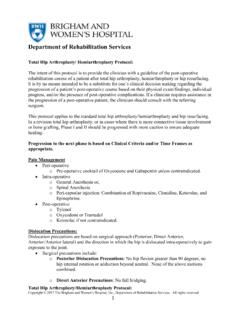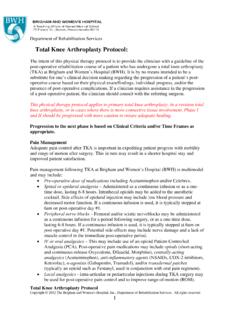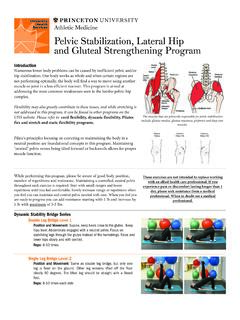Transcription of CONSERVATIVE MANAGEMENT FOR …
1 1 CONSERVATIVE MANAGEMENT FOR FEMOROACETABULAR IMPINGEMENT (FAI) This protocol is intended to provide the clinician with instruction, direction, rehabilitative guidelines and functional goals for the CONSERVATIVE treatment of femoroacetabular impingement (FAI). It is not intended to be a substitute for clinical decision-making regarding the patient progression based on physical exam/findings and individual progress. The physiotherapist must exercise their best professional judgment to determine how to integrate this protocol into an appropriate treatment plan. The general treatment guideline involves stretching/mobilizing any tight or restricted structures, strengthening the hip musculature and most importantly ensuring that there is adequately lumbo-pelvic stability ( core strength).
2 This protocol divided into 2 phases. Actual progress may be faster or slower depending on the individual. Decisions to advance patients through the phases of rehabilitation should be based on the clinical presentation and response to treatment (this includes the use of outcome measures such as hip range of motion (ROM), Hip Outcome Score (HOS), Harris Hip Score, P4, Lower Extremity Functional Scale (LEFS) ). As an individual s progress is variable, this protocol must be individualized for optimal return to activity. Some exercises may be adapted depending on the equipment availability at each facility. There may be slight variations in this protocol depending on findings at the time of assessment ( hip hypo or hyper mobility). If a clinician requires assistance in treatment progression please contact the referring physician or the physiotherapy department.
3 FEMOROACETABULAR IMPINGEMENT Femoroacetabular impingement is characterized by decreased joint clearance between the femoral head/neck and acetabulum (ball & socket). There are two described types:9 Cam impingement is defined as an abnormality of the anterolateral femoral head/neck junction Pincer impingement is described as over coverage of the acetabulum over the femoral head causing increased compressive forces between the rim of the acetabulum and the femoral head/neck. In the majority of cases (86%)11, cam and pincer forms exist together mixed impingement . HIP BIOMECHANICS, ELECTROMYOGRAPHY (EMG) AND ASSESSMENT GUIDELINES It is important to note that FAI is prevalent in those who are asymptomatic as This indicates that FAI may not be the cause of hip joint pathology/degeneration or soft tissue injury.
4 Faulty biomechanics such as joint hypo or hyper-mobility (including generalized ligament laxity), altered motor control strategies around the lumbar-pelvic-hip region, hip weakness/muscle imbalances and postural mal-alignment are some of many causative factors for hip pain. Our ability to assess these deficits and to tailor a MANAGEMENT program is essential for optimal pelvic/hip control and more important function. Surface EMG from normal lateral hip muscles have shown reciprocal phasic low level activity during This means that left and right musculature alternate their activity normally in an on-off (load/unload) strategy. With lumbo-pelvic-hip dysfunction, the pattern shifts more toward tonic activity with a loss of phasic (Type II) muscle fibres in the superficial hip abductors and an abnormal co-contraction strategy of both GMed 2 During routine activities such as walking, going up/down stairs, standing up/sitting down and weight shifting onto one leg, the hip joint averages contact forces between times The abductorial forces required to maintain a level pelvis during single leg weight bearing, are comprised of 70% from the gluteal muscle forces and 30% from muscles that influence tension in the iliotibial band ( tensor fascia lata and the upper portion of glueus maximus).
5 16 As a result, these muscles groups are fundamental when addressing lumbo-pelvic-hip dysfunction and pain. POSTURAL HABITS Common postural habits include sitting cross-legged in hip adduction, sleeping in side-lying with the hip in flexion/adduction but the most common negative standing postural habit for hip stability is hanging on one hip where the trunk and body weight is shifted towards one leg with the weight bearing hip/pelvis in a position of adduction. In this position of hip adduction ( trendelenberg), many negative biomechanical consequences have been shown to occur: 1. increased hip joint forces ( joint compression).16,17 2. increased compressive loading of the ITB over the greater trochanter into which the Gluteus Medius (GMED) tendon 3.
6 The requirement for hip muscle activity is decreased (because the ITB is taut) and the forces to overcome gravity are mostly resisted by ITB tension This poor postural habit ( excessive hip adduction in weight bearing) can lead to additional negative consequences such as structural muscle lengthening changes over time ( additional sarcomeres).20 This shifts the optimal function of the muscle such that the greatest isometric tension is now generated in a new lengthened position. This may be evident with manual muscle testing of hip abductors ( the shortened or neutral position tests weak and the lengthened position, such as 10 adduction, tests strong). If this postural patterning is not addressed and corrected, it can lead decreased force production with the hip in a neutral position.
7 This can lead to painful pathomechanics such as increased compressive loads in the hip joint with resultant joint dysfunction/degeneration and/or muscular tendonopathies. Assessing and retraining poor postural habits is a crucial consideration for achieving positive long term strengthening EXERCISES Most weight bearing strengthening exercises have been show to produce significantly higher gluteal muscle activity vs. non-weight bearing exercises as there is a need for greater external torque forces on the pelvic-hip These findings relate to the weight of the leg and lever arm over coming the effect of gravity; three factors that are very important to consider with exercise progression. Post-operatively exercises will commence as ROM and non weight-bearing strengthening exercises ( supine and standing).
8 Logical progression is from 2-legged weight bearing ( squats, ) to single limb ( step-ups, step-downs, single leg ). An EMG summary sheet is provided for gluteal muscle activation (GMax and GMed) levels for a variety of common therapeutic exercises given in rehabilitation from numerous articles in the 3 ACUTE PHASE I: 0-4 WEEKS GOALS Patient education re: rest, NSAIDs, activity/ADL modification to adapt to hip morphology, decrease compression and painful movements, cessation of sports or other aggravating factors Address hip ROM deficits if any Stretching structures abound hip complex muscles, capsule (if needed and if pain free) Address motor control deficits around lumbo-pelvic-hip complex strengthening weak key muscle groups Baseline proprioception and effective weight transfer without compensatory movement patterns exercise SUGGESTIONS ROM & Flexibility Stretches/ROM: - Hip extension / anterior capsule, - Hip flexion, Add/Abductors - IR at 0 and in flexion positions, ER Quadruped rocking for hip flexion (pain free, ensure neutral spine) Stationary bike high seat avoid deep hip flexion (pain) Distraction.
9 Manual/belt assist in restricted ROM **only indicted if loss of motion in a particular range Muscle Strength & Endurance Lumbo-Pelvic (core stability): supine Transverse abdominis (TA) and Pelvic floor setting. **cueing should be specific to lifting pelvic floor and indrawing lower abdominal (effort scale for pelvic floor/abdominal contraction should be 2-4 out of 10 with normal breathing) Basic supine TA and pelvic floor: Inner range bent knee fall outs full range heel march march (active hip flexion) heel slides heel slides + hip flexion (assisted with belt under femur active) single leg heel taps as tolerated **Requires activation of TA and pelvic floor to maintain centralization of the femoral head with lower extremity exercise Standing, sitting, walking, and weight-bearing postures with TA and pelvic floor Hip/Gluteals/Hamstrins/Quadriceps: Prone hip extension off edge of bed Clam shells isometric side lying hip abduction isotonic hip abduction supine bridging.
10 Double, single, on ball Standing hip extension, abduction progress to pulleys or ankle weights (do not allow trunk shift) Shuttle 2 1 leg as tolerated Squats: wall, mini, progress to deeper squats as able Proprioception: 2 legs: Equal weight bearing: forward/backward and side-to-side progress to single leg weight shift with core activation and hip/pelvic control Wobble boards with support: side-to-side, forward/backward 4 Standing on foam roller: balance rocking forward/backward SUB-ACUTE PHASE II: 4-12+ WEEKS GOALS Continue flexibility exercises in pain free ranges if required Progress exercises to include more challenges to lumbo-pelvic-hip control (core stability) Strengthen weak key muscle groups with functional closed chain exercises Progress proprioception to single leg without compensatory movement patterns exercise SUGGESTIONS ROM & Flexibility Quadruped rocking with IR/ER bias Stationary bike Elliptical forward (with TA/pelvic floor setting)/backward Stairmaster with TA/pelvic floor setting and adequate pelvic/hip control ( absent trendelenberg, pelvic rotation) Treadmill.









